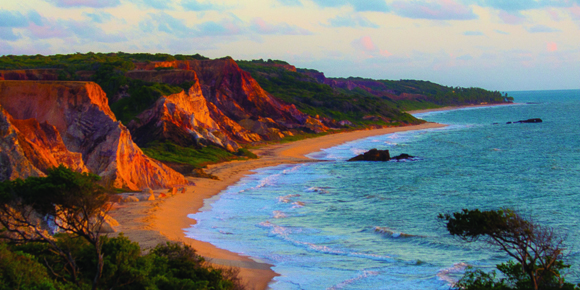Several theories exist regarding the origin of the place-name, Brazil, a country much in the world’s spotlight over the last few weeks.
One ancient Irish legend tells of a ghost island somewhere in the North Atlantic. Mist so thoroughly envelops this island that it becomes visible for only one day in every seven years. Called Hy-Brazil, the island can be located on an 1840 Catalonian map where it is named, Illa de brasil. Translated from the original Celtic, Hy-Brazil means, “Blessed Lord.”
Supposedly, the Portuguese explorer, Pedro Alvares Cabral, believed he’d found this mythical island when he sighted Brazil in 1500. Since that is what he called the place, this story could have some basis in truth.
However, the Cabral tale conveniently ignores the fact that Brazil already had been given a name by previous European visitors. Originally, it was called, Ilha de Vera Cruz (Island of the True Cross). Then it became known as Terra de Santa Cruz (Land of the Holy Cross). Both names were used before the island was ever called Brazil.
A second theory links Brazil’s name to the brazilwood tree, a tree deep red on its inside and one that became a valuable source of dye. Portuguese explorers called this tree, pau-brasil. Pau is Portuguese for “stick” and brasil is thought to have evolved from the Portuguese word, brasa (ember).
Because the dye made from these trees soon became a significant export, the land they came from began to be called Brazil.
But another tropical tree also incorporates the word, “brazil.” The brazilnut tree grows in many South American countries, including Venezuela, Bolivia, Peru and, of course, Brazil. In fact, Brazil is not the chief exporter of either brazil nuts or brazil wood. That country happens to be Bolivia.
And so, the reason Brazil became Brazil, and what that word really means, remain mysteries to this day.
Rio de Janeiro is another story. This city once was capital of Brazil but, in 1960, Brasilia was designated the capital. The change theoretically occurred because Rio, as a port city, is more vulnerable than an inland metropolis like Brasilia.
Rio de Janeiro means “River of January” and was so-named because the Portuguese explorer, Gaspar de Lemos, sailed into Rio’s harbour on New Year’s Day, 1501, believing the harbour to be the mouth of a river.
Another word heard during the Games was carioca. This term for a resident of Rio de Janeiro is derived from the Tupi Indian word, karioka (house of white men).
Carioca reminds us that white people were not the original Brazilians. About 66 per cent of the population is of African descent. The first Africans were brought as slaves to work in the sugar industry. Brazil abolished slavery in 1888. But the first Brazilians were indigenous tribes such as the Aruba, Ticuna, and Wirina Indians. Today, some 200 bands of indigenous people live on the island, a mere remnant of their original numbers.
As happened wherever white empiricists settled, they did their utmost to subjugate and eradicate the natives. Still, Brazil claims that, today, Indians are making a comeback.



